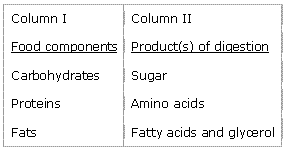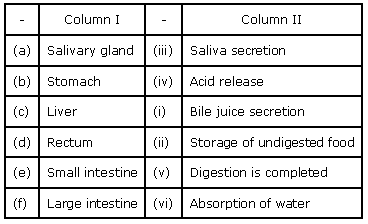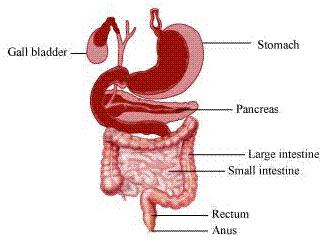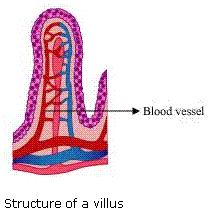Class 7 NCERT Solutions Science Chapter 2 - Nutrition in Animals
Nutrition in Animals Exercise 20
Solution 1
(a) Ingestion, digestion, absorption, assimilation and egestion.
(b) Liver
(c) Digestive
(d) Villi
(e) Food vacuole
Concept insight: Important from Exam Point of View.
Solution 2
(a) Digestion of starch starts in the stomach. (F)
Concept insight: Digestion of starch starts in mouth. In stomach digestion of proteins start.
(b) The tongue helps in mixing food with saliva. (T)
Concept insight: Recall the functions of tongue.
(c) The gall bladder temporarily stores bile. (T)
Concept insight: The gall bladder stores bile secreted by the liver.
(d) The ruminants bring back swallowed grass into their mouth and chew it for some time. (T)
Concept insight: The partially digested food called cud returns to the mouth in small lumps and the animal chews it.
Solution 3
(a) Small intestine
Concept insight: Digestion of food is completed in small intestine.
(b) Large intestine
Concept insight: Absorption of water from undigested food takes place in the large intestine.
Nutrition in Animals Exercise 21
Solution 4

Concept insight: Recall the products of digestion of food components.
Solution 5
Small finger like projections from the walls of small intestine are called villi. It is provided with blood vessels. Villi increase the surface area of small intestine for absorption of digested food.
Solution 6
Liver secretes the bile juice which is stored in the gall bladder. Bile plays an important role in the digestion of fats. It breaks down the larger fat globules to smaller fat globules (emulsification) and thus helps in enzymatic action on the fats.
Concept insight: Without bile juice fats cannot be digested.
Solution 7
Cellulose is a type of carbohydrate that can be digested by ruminants and not by humans. Ruminants have a large sac-like structure between small and large intestine where the food containing cellulose is digested by the action of certain bacteria. On the other hand, humans cannot digest cellulose, as the cellulose digesting enzymes are absent in them.
Concept insight: That large sac is called Caecum. It is well developed in ruminants but not in humans. It contains bacteria which produce an enzyme called cellulase which digests cellulose.
Solution 8
Glucose is a simple sugar. Carbohydrates, when consumed, gets digested into glucose. As glucose can be easily absorbed in blood, it provides instant energy to the body.
Hence, when glucose is taken directly, it does not have to be digested and thus acts as an instant source of energy.
Concept insight: Carbohydrates are absorbed in the form of glucose which provides instant energy.
Solution 9
(i) Absorption of food: Small intestine
(ii) Chewing of food: Buccal cavity_(teeth).
(iii) Killing of bacteria: Stomach (hydrochloric acid)
(iv) Complete digestion of food: Small intestine
(v) Formation of faeces: Large intestine
Concept insight: Recall the process of digestion in human beings.
Solution 10
Both Amoeba and human have holozoic type of nutrition.
Differences between nutrition in Amoeba and human beings.
|
|
Digestion in Humans |
|
Digestion in Amoeba |
|
(i) |
Humans have a mouth and a complex digestive system. A human ingests food through mouth. |
(i) |
Mouth and digestive system are absent in Amoeba. It ingests food through pseudopodia. |
|
(ii) |
Digestive juices are secreted in the buccal cavity, stomach, and small intestine. |
(ii) |
Digestive juices are secreted in the food vacuole. |
|
(iii) |
Digestion of carbohydrates, proteins, and fact starts in separate regions. |
(iii) |
All the food components are digested in the food vacuole. |
Solution 11

Concept insight: Recall the process of digestion in human beings.
Nutrition in Animals Exercise 22
Solution 12

Solution 13
No. Humans cannot survive only on raw, leafy vegetables, or grass. It is because the grass is rich in cellulose, which is a type of carbohydrate that humans are not able to digest due to the absence of cellulose-digesting enzymes.
Concept insight: Recall the concept of digestion in ruminants.


